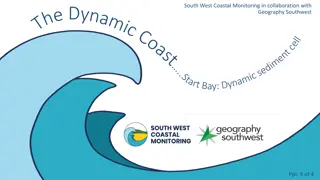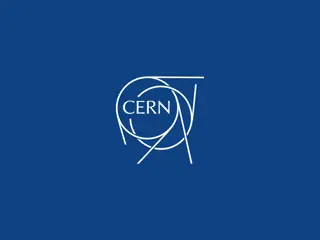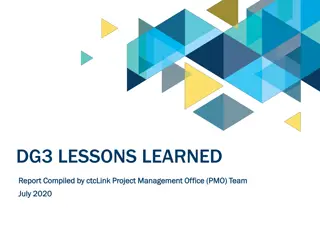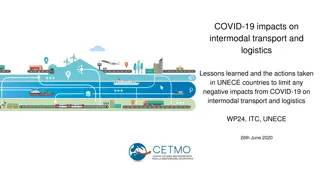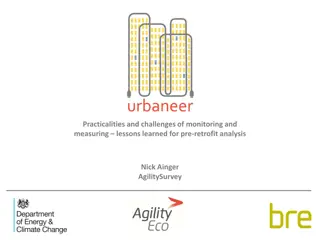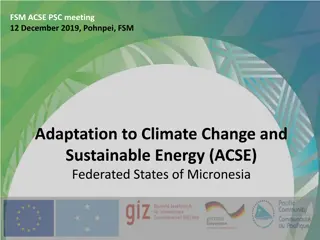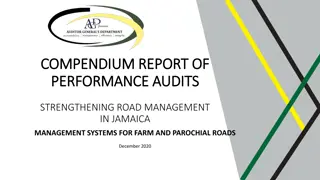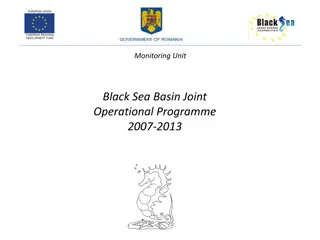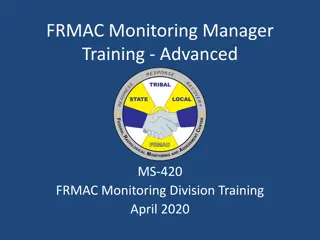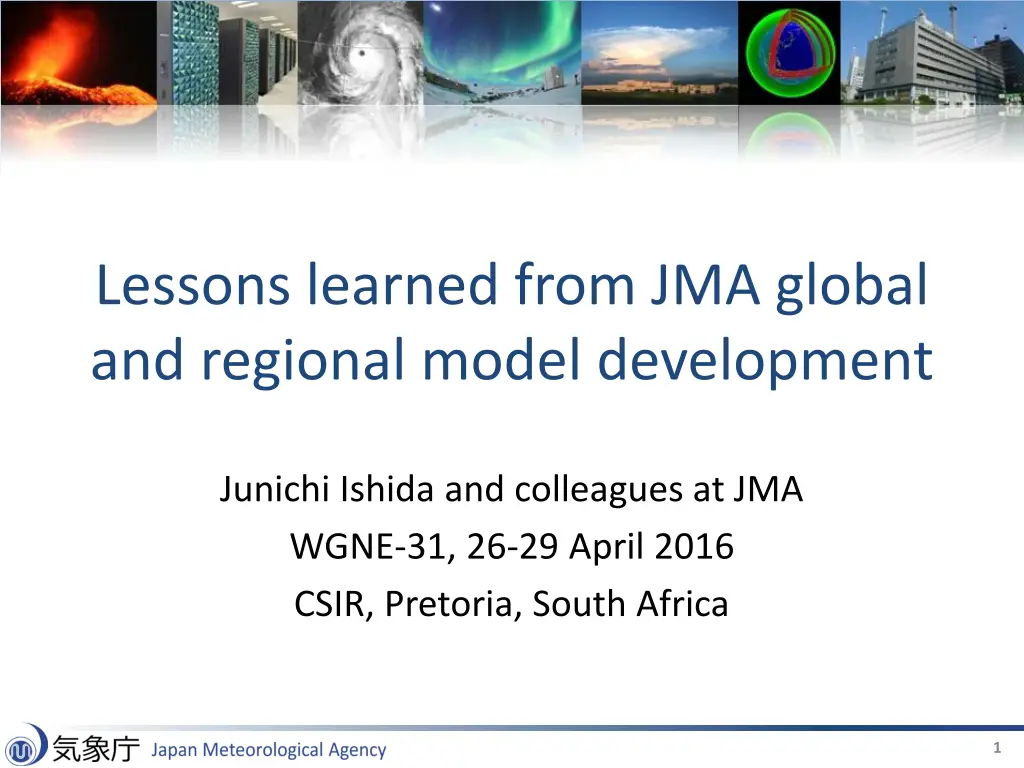
Lessons Learned from JMA Model Development
Explore the key lessons from Junichi Ishida and colleagues at JMA regarding global and regional model development, focusing on cloud scheme and cumulus parameterization, motivation, improved convection and cloud schemes, and grid point storm impacts.
Download Presentation

Please find below an Image/Link to download the presentation.
The content on the website is provided AS IS for your information and personal use only. It may not be sold, licensed, or shared on other websites without obtaining consent from the author. If you encounter any issues during the download, it is possible that the publisher has removed the file from their server.
You are allowed to download the files provided on this website for personal or commercial use, subject to the condition that they are used lawfully. All files are the property of their respective owners.
The content on the website is provided AS IS for your information and personal use only. It may not be sold, licensed, or shared on other websites without obtaining consent from the author.
E N D
Presentation Transcript
Lessons learned from JMA global and regional model development Junichi Ishida and colleagues at JMA WGNE-31, 26-29 April 2016 CSIR, Pretoria, South Africa 1
Introduction JMA operates a global model (GSM) with a horizontal resolution of 20km and 2 regional models with a horizontal resolution of 5km (MSM) and 2km (LFM). GSM was upgraded in March 2016 and LFM was upgraded in January 2015. We gained following lessons through the development of both systems. I would like to share them and discuss about them. Cloud scheme and Cumulus parameterization of GSM Grey zone of convection at LFM 2
CLOUD SCHEME AND CUMULUS PARAMETERIZATION OF GSM 3
Motivation JMA global model (GSM) with a horizontal resolution of 20km employs convection scheme and cloud scheme. For convection; Prognostic Arakawa-Shubert type parameterization For cloud; PDF (a top hat function)-based scheme (Smith 1990) Both schemes have been modified and they are implemented in GSM in March 2016. The new global model with another modifications (radiation, land surface model etc.) shows significant improvement in the TC track and precipitation forecast skill and reducing dry and cold bias in the tropical mid-troposphere. During the development, we recognized the necessity to modify cloud scheme in order to adjust to the change of characteristic of new convection scheme. 4
Improved convection and cloud scheme List of major changes Convection (Prognostic Arakawa-Schubert type) Improving of melting process Inclusion of the auto-conversion process in the updraft Modification to the static energy at the cloud base Cloud (PDF-based scheme (Smith 1990)) Excluding time-step dependency from the icefall process Removing the cumulus effect on the PDF width Modified global model with changed convection scheme showed significant increase of grid point storm Removing the cumulus effect on the PDF width was also developed based on the research to clarify the new characteristic of grid point storm. 5
Grid Point storm with new convection scheme Old model Modified convection scheme GSM with a modified convection scheme showed significant increase of unrealistic grid point storm in the tropics in the development 6
Cloud scheme in GSM PDF scheme based on Smith 1990 Total water is divided into water vapour and cloud water using PDF A top hat function is employed as PDF The convection scheme does not count the cloud amount and water in convection explicitly because of the assumption that the convection area is too small and negligible. To count the cloud amount and water, the PDF width was stretched to increase the amount of cloud. Historically, the treatment was introduced to modify the low bias of mid level cloud in the tropics. The treatment reproduces too much cloud water which results in too much precipitation. PDF Water vapour Width s Cloud water Total water qT Mean total water qT Saturated relative humidity q* 7
Bias of specific humidity Reducing the effect of convection in PDF width shows significant improvement of dry bias in midlevel in the tropics, because Too much conversion from water vapour to precipitation via cloud water was improved. More activated convection brought more mid level humidity by detrainment. Q700 New Old Verification against sonde; mean error at T+72, from July to September in 2015
Improvement of precipitation skill New Old Bias Score Equitable Threat Score Hit Rate False Alarm Rate Verification against surface obs. in Japan from T+3 to T+84, from July to September in 2015 Threshold of 1mm / 3hour, red and blue line indicates new and old model respectively Up to T+12; Bias Score becomes close to 1, Equitable Threat Score, Hit Rate and False Alarm Rate increase significantly. From T+12 to T+57; Though Bias Score increases over 1, Equitable Threat Score and Hit Rate increase significantly and False Alarm Rate reduces significantly. From T+60; False Alarm Rate is almost neutral and Hit Rate increases significantly. 9
Future issues Midlevel cloud amount decreases especially in the tropics and the accuracy of short wave radiation flux at surface is deteriorated. It might cause unfavorable effect to global circulation. Representation of the effect of cloud amount and water of convection is next issue for JMA global model New radiation scheme which considers the effects is under development. Old New New with developing scheme Verification of downward short wave radiation at surface against CERES; mean error at T+72, from July to September in 2015 Note: the results is not only by the change of convection but also by the change of radiation scheme 10
Lessons Learned Midlevel humidity in the tropics is quite sensitive to PDF width with a top hat type function. Precipitation forecast accuracy might be also sensitive to it. Though consideration of the effect of convection in the PDF is not unnatural, the uncertainty of the PDF width is too large and difficult to determine it. To consider the effect we are developing to modify not cloud scheme but radiation scheme. When the effect of convection scheme is considered in the cloud scheme, impact to the cloud scheme should be investigated during the development of convection scheme. 11
Motivation JMA operates 2km model (LFM) with following objectives Providing information for aviation weather forecast Disaster prevention especially caused by heavy precipitation Verifications show that LFM is able to predict smaller scale heavy precipitation, but also reveal serious problems that Start of convective heavy rain is often delayed. The convective precipitation intensity is too high. The less accurate of forecast of timing and intensity of convective precipitation is serious not only for forecasters to issue warnings or advisories, but also for computational stability. Some operational NWP centres or consortia (ex. Met Office, COSMO) also face similar problems. Information from European Working Group on Limited Area Modeling (EWGLAM) meeting in 2015. We have tried to solve the shortcomings and I would like to introduce the lessons learned from the development. 13
Grey Zone problem Ex: convection Partially resolved by grid-mean vertical velocities Not represented by grid-mean vertical velocities at all Grid-mean vertical velocities can represent all vertical transport (m) ? All transport should be parameterized No parameterizations are necessary In the Gray Zone, resolved and unresolved phenomena are mixed. Vertical transport Convective initiation Entrainment/Detrainment 14
Processes in convection vertical transport entrainment detrainment initiation / trigger (forced lifting by convergence, topography, growing PBL) Vertical transport: Significant part is explicitly resolved in the LFM Entrainment / detrainment: Not resolved in the LFM They are caused by very small vortexes. Initiation / trigger: Partly resolved in the LFM Large scale divergence is resolved while small scale divergence or trigger caused by small scale (ex. dispersion of topography) is not resolved. Different approach from traditional cumulus parameterization is required! 15
Horizontal Diffusion; not worked well As a parameterization of entrainment / detrainment Smagorinsky type horizontal diffusion scheme was tested to parameterize the effect of entrainment / detrainment but was not worked well Test of diffusion for momentum, PT and QV Test of diffusion for PT and QV It worked not only on unstable columns but also on stable columns and the smoothed field suppresses the trigger of convection Test of diffusion from LFC to LNB It worked mainly on top of convection which strengthen the unstableness and not the boundary but top of convection cell Therefore the diffusion was not employed in the LFM. Problems Is the down gradient type diffusion is adequate to parameterize entrainment / detrainment? How to distinguish the boundary of convection cell? 16
Horizontal Diffusion Tendency of Qv W EPT Vertical cross section of W, EPT and time tendency of Qv by the new horizontal diffusion scheme which works from LFC to LNB. The scheme mainly works on the top of convection cell and not at the boundary of convection cell. 17
Introducing a parameterization for convective initiation(PI) Based on the existing convective parameterization (Kain-Fritcsh, employed by JMA s 5-km operational mesoscale model), but tendency from convective process is much smaller than the original one (assuming slower convective stabilization) At the initiation stage, if the dynamics does not produce updraft due to convection even with unstably stratified layer realized, the parameterization is activated and modifies layer stratification by weakly transporting heat and moisture vertically and releasing latent heat through phase transition of water, resulting in producing local low pressure area. Once such local low pressure area is generated, the dynamics of the model calculates convergence into the low pressure area and promotes development of convection. Because it acts very weakly, the parameterization just helps dynamics foster convective system. 18
Time series of precipitation frequency Red bars: observation Pink lines : LFM Green Lines: asuca without PI, Blue Lines: asuca with PI over 1mm/h over 10mm/h Even without PI, asuca improves peaks of frequency compared with LFM. By employing PI, peaks of frequency almost coincide with observed ones, though frequency of prep >= 1mm/h is still too low and that of prep >=10mm/h is still too large 19
Lessons Learned LFM had serious problems that the start of convective heavy rain was often delayed and the convective precipitation intensity was too high. A 2km model can not resolve all processes in convection, especially entrainment / detrainment can not be resolved at all. Smagorinsky horizontal diffusion scheme was tested but not worked well. It mainly worked on the top of convection and not the boundary of convection. Is down-gradient type diffusion adequate? How to distinguish the boundary of convection? Modified existing convection parameterization to parametrize the effect of trigger / initiation was tested and improves the timing of convection. Too strong convection cells still remain in the model due to the lack of entrainment / detrainment. For more sophisticated treatment of convection in 2km model How to parameterize the entrainment / detrainment? How to develop more sophisticated initiation parameterization? Small scale orographic effect such as dispersion or other trigger? 20



